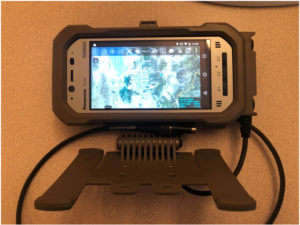Have you ever dropped a smartphone, even one that you’ve spent the extra money for the hardened case that surrounds it, and still have the screen crack? Do you work outside, in the rain, with gloves on and get frustrated because you cannot get your smartphone to work in the rain, or with gloves? Do you get frustrated not being able to see your screen while outside on a sunny day? How many times have you looked around for a power outlet because your phone was about to die and you wished you could just replace the battery? If those scenarios describe your frustrations with your current smartphone, then please let me introduce the new Panasonic Toughbook FZ-N1 Tactical, the Fully Rugged Android handheld that solves those problems.
Most know the N1 as the built-in scanning device that delivery service carriers have to scan the packages as they deliver them, but this new N1 Tactical will not have the scanner. The first version of the scanner-less N1 was a Wi-Fi device only, but with its rugged (MIL-STD-810G and IP 65/66/67/68), small form factor, and consistent size, weight, and power in versions, it was a logical choice to implement for tactical handhelds. Panasonic listened to their customers and the N1 Tactical to be released in July, 2020, will come in Wi-Fi only, one SIMM, or dual SIMM versions (AT&T and Verizon, FirstNet capable), and all variants will be the same size, weight, and power. Full specifications have not yet been released, but it will come with a Multi-core Qualcomm CPU capable of supporting Android 9 or 10 OS, which is capable of running the latest versions of ATAK, APAS, or other situational awareness applications and plugins. The 4.7 inch HD 1280 x 720 screen is daytime viewable. With its 10-point capacitive, multi-touch display, the N1 works in the rain and with gloves with the Panasonic patented rain sensing and glove input modes. It will have two cameras, full HD 5MP in the front and 8MP rear. It comes with a 12-hour removable, warm swappable battery that can fully recharge within two hours. All N1 variants come with three programmable buttons, so all those applications you would want to get to quickly can be programmed to show up (or go away) at the push of a button.
Quantico Tactical worked with Juggernaut Design and developed cases and cables for the N1. You can choose a Fischer connector to plug directly into an L3Harris AN/PRC-152A side hat adapter, or a Nett-Warrior standard cable that will plug into any of GlenAir’s StarPan hubs. The latter option is particularly useful since the N1 will charge while in use, giving you even more time to complete the mission. To make it easy for customers, we are working with Panasonic to list the Nett Warrior case/cable solution with Panasonic as an available-to-order accessory.

Panasonic’s three year warranty is the best out there, so if you and/or your team are really rough on your handheld devices, you can still get support. In the rare event of a failure, devices will be delivered overnight, at no expense to you, to and from the US-based service center with a sub 2-day average repair turnaround. For any technical issues, you can leverage the 24/7 US based technical support hotline, 1-800-LAPTOP5. You can also have the peace of mind that when a new version comes out that you can still use the same cases and cables as you have previously, which is not only a significant cost savings, but allows you to keep your kit exactly the way you had it.
If you are interested in the N1 Tactical, you can contact us at Quantico Tactical.